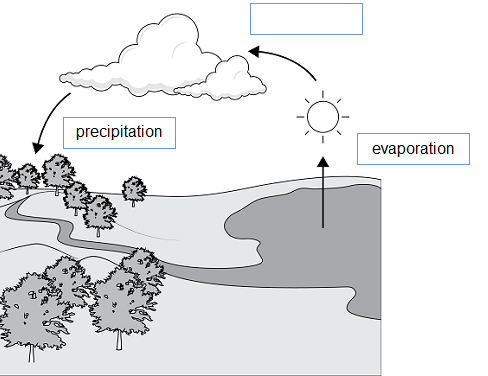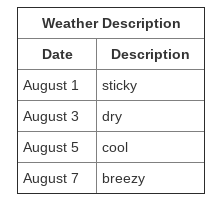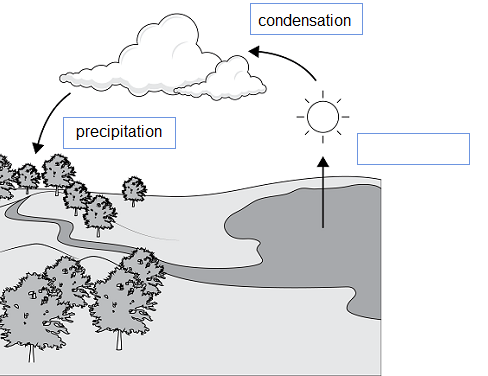What part of the water cycle is missing?
A. humidity B. snow C. condensation

C. condensation
Look at the picture and complete the sentence.
The trees in the picture will reduce the impact of a. drought b. lightning c. strong winds on the building.
c. strong winds
Romeo asked 10 teachers on four different days to describe the weather using one word. The top selection for each day is shown in the table.

Look at the table. On which day was the humidity most likely the highest?
A.August 1 B.August 3 C.August 5 D.August 7
A.August 1
A scientist is looking at this ring.
By studying tree rings, the scientist can study the A. soil temperature B. elevation C. greenhouse gases D. climate of the area surrounding the tree’s location.
D. climate
What part of the water cycle is missing?
A. precipitation B. temperature C. evaporation

C. evaporation
To prepare for a storm, a family placed sandbags in front of their home.
What are the sandbags most likely being used for?
- A. to prevent heavy winds from breaking their windows
- B. to collect water in case there is a drought
- C. to stop floodwater from getting inside the house
- D. to keep hail from breaking the sidewalk in front of the house
C. to stop floodwater from getting inside the house
Use the graph to answer the questions.
Which two types of weather occurred the most?
A.snowy weather B.cloudy weather
C.sunny weather D.partly cloudy weather
C.sunny weather D.partly cloudy weather
The Sahara is a desert near the equator in Africa. How does the climate of the Sahara differ from an area in the polar climate?
- A.The Sahara climate is cool all year. The climate in the polar zone is wet all year.
- B.The Sahara climate is humid all year. The climate in the polar zone is hot all year.
- C.The Sahara climate is wet and humid all year. The climate in the polar zone is warm all year.
- D.The Sahara climate is hot and humid all year. The climate in the polar zone is cold all year.
D.The Sahara climate is hot and humid all year. The climate in the polar zone is cold all year.
Bodies of water have an important effect on weather. The larger the body of water, the greater the impact on the weather.
Choose the correct word to complete the sentence.
Areas near a. a river b. a lake c. an ocean tend to get the most precipitation.
c. an ocean
The area in the picture is having a A. snowstorm B. drought C. flood
The area has gone a long time with little or no A. weather B. wind C. rain
B. drought
C. rain
The Gomez family has two weather instruments in their home.
The Gomez family use a A. hygrometer B. barometer C. thermometer to measure air temperature.
They use a A. barometer B. hygrometer C. thermometer to measure humidity.
C. thermometer
B. hygrometer
Which questions can a scientist help to answer by studying tree rings? Select the three that apply.
- A.Did the area of the tree experience warm temperatures and a lot of precipitation?
- B.How many trees populate the area where this tree is located?
- C.Did the climate of the area where the tree is located change?
- D.What is the age of the tree?
- A.Did the area of the tree experience warm temperatures and a lot of precipitation?
- C.Did the climate of the area where the tree is located change?
- D.What is the age of the tree?
What is the name for snow, snow, sleet, and hail?
precipitation
The Noelle family lives in Kansas. One day in July, a big storm with heavy rain and damaging winds was forecast. Later in the day, a siren went off warning everyone to get to safety.
The siren is warning people of a
A. tornado B. drought C. weather D. hurricane
A. tornado
Weather is......
what is happening outside right now
Areas that are farthest from Earth’s equator have A. cold B. warm C. more D. less climates.
This is because these areas receive A. cold B. warm C. more D. less direct sunlight during the year than areas near Earth's equator.
A. cold
D. less





